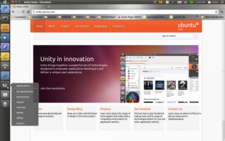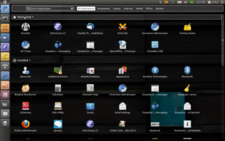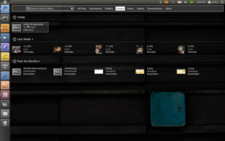2D Unity Not on the Natty Plan Says Canonical
“It's not on the Natty plan for now, but we'll be evaluating the progresses and will consider adding a 3rd session option if the development goes as planned,” said David Barth, Desktop Experience Team, Engineering Manager at Canonical.
Unity 2D developer and Canonical OEM team lead, Bill Filler, created a lot of buzz around the 2D Unity option last week when he published a post entitled Unity 2D. Filler’s original post was unavailable for several days and subsequent is now available again to the public and the screenshots included are from that post.
The removal of the Filler’s blog post prompted Linux Pro Magazine Online (LPMO) to contact David Barth, Engineering Manager for Desktop Experience (DX) Team, at Canonical, to find out the more about the future of the 2D Unity option in the Natty release.
Barth clarified that Filler is the developer and the DX Team participates in the development of the project by sharing foundational elements such as bamf, dee, places and more.
LPMO asks Barth, “Will there be a 2D Unity Option available for Ubuntu 11.04?" “It's not on the Natty plan for now, but we'll be evaluating the progresses and will consider adding a 3rd session option if the development goes as planned,” said Barth an exclusive interview with LPMO. “For Natty, the plan is still to have Unity 3D and the Gnome classic session as a 2D fallback,” continued Barth. “The classic Gnome desktop will be kept as the safe and recommended default, even if a 3rd session is added. This is important for a lot of our users, in the community or in enterprises,” he added.
Barth said that people who don't have the kind of 3D support Unity requires because either they have old cards, or brand new ones that have issues with drivers as well as ARM systems without 3D drivers were the target audiences the DX team at Canonical had in mind when it starting the project.
“2D Unity, will not require require proprietary graphics card drivers, it will require regular 2D acceleration support; however, in an unaccelerated, plain framebuffer it doesn't work that well,” says Barth.
Barth wanted users to know a little more about the 2D Unity option. “Unity-qt is exemplar in 2 ways. First, it brings some more reality to the notion of Gnome Platform,” he noted.
“It reinforces how we've constructed Unity so far, ie by preserving the investments that have been made in the Gnome libraries and infrastructure. And by adding some additional "Ayatana" sauce (which we now call "Unity Foundations") to provide the overall foundations for the Unity Desktop Shell. Unity-QT, despite using the QT toolkit, reuses all of the underlying libraries that the regular Unity Shell is using," Barth said.
Barth first realized Gnome could be a "platform supporting different toolkits or shells" at Guadec in 2009, as Vincent Untz was introducing a QT presentation. According to Barth, “Vincent was seeing QT as an alternative toolkit running on top of the rest of the Gnome Platform." Barth said Untz's introduction was more in the context of Gnome Mobile; however he adds, “It now sounds really premonitory.”
Barth also wanted to further that platform idea, “I wanted to underline the importance of QML in Unity-QT.” Barth says, “QML really made a difference in how fast the Unity-QT implementation could be developed and to their credit, the unity-qt developers are very sharp as well!” Barth added, “This example shows how a toolkit can "reinvent" itself with some contemporary web technologies.”
For user who want to know more about 2D Unity the code and PPA is publicly available.
Comments
comments powered by DisqusSubscribe to our Linux Newsletters
Find Linux and Open Source Jobs
Subscribe to our ADMIN Newsletters
Support Our Work
Linux Magazine content is made possible with support from readers like you. Please consider contributing when you’ve found an article to be beneficial.

News
-
Parrot OS Switches to KDE Plasma Desktop
Yet another distro is making the move to the KDE Plasma desktop.
-
TUXEDO Announces Gemini 17
TUXEDO Computers has released the fourth generation of its Gemini laptop with plenty of updates.
-
Two New Distros Adopt Enlightenment
MX Moksha and AV Linux 25 join ranks with Bodhi Linux and embrace the Enlightenment desktop.
-
Solus Linux 4.8 Removes Python 2
Solus Linux 4.8 has been released with the latest Linux kernel, updated desktops, and a key removal.
-
Zorin OS 18 Hits over a Million Downloads
If you doubt Linux isn't gaining popularity, you only have to look at Zorin OS's download numbers.
-
TUXEDO Computers Scraps Snapdragon X1E-Based Laptop
Due to issues with a Snapdragon CPU, TUXEDO Computers has cancelled its plans to release a laptop based on this elite hardware.
-
Debian Unleashes Debian Libre Live
Debian Libre Live keeps your machine free of proprietary software.
-
Valve Announces Pending Release of Steam Machine
Shout it to the heavens: Steam Machine, powered by Linux, is set to arrive in 2026.
-
Happy Birthday, ADMIN Magazine!
ADMIN is celebrating its 15th anniversary with issue #90.
-
Another Linux Malware Discovered
Russian hackers use Hyper-V to hide malware within Linux virtual machines.




Dock on the left
Unity? No Thanks
I also don't like the unified menus. No all the apps I use work with the new scheme. The result, more screen taken up. In the future, if all gnome and kde apps play along with Ubuntu's unified menu, I might reconsider.